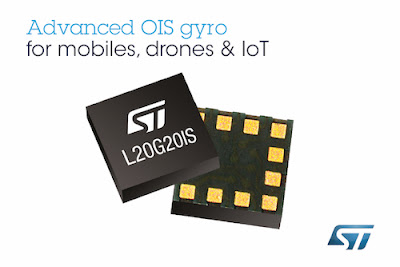STMicroelectronics is a Swiss-based electronics and semiconductor
manufacturing company. L20G20IS is the latest Gyroscope launched by
STMicroelectronics. The L20G20IS is a miniature 2-axis gyroscope; its
dimensions are 2.0mm x 2.0mm x 0.7mm.
 |
| STMicroelectronics' L20G20IS Advanced Gyroscope |
With respect to the area of the chip, these miniature
dimensions are going to save an area of 1.29 square millimetres. Though this
area seems to be very little, in the perspective of VLSI technology, this
enables the designers fill the are a with a complete new module.
Usually, the substrates to integrate camera modules in
smartphones are 0.2mm or 0.3mm in thickness. The ultra-thin L20G20IS allows the
designers to integrate the module into the substrate, which eliminates the “camera-bump”
we see on our regular smartphones.
Zero-Rate Level (ZRL):
Usually, image stabilization in a camera is decided by the parameter
Zero-Rate Level (ZRL). It is also called Offset Calibration Error (OCE) sometimes.
In simple words, this is the basic unit of measurement in a gyroscope – i.e.,
it is defined when there is no angular velocity applied in a given gyroscope.
The STMicroelectronics’ L20G20IS ensures that it lies within given
specifications, which plays a major role in image stabilization.
Rate Noise Density (RND):
Rate Noise Density (RND) is another parameter that affects image
stabilization with respect to noise acquired during the image capture; higher
the RND, better the stabilization. With L20G20IS, the RND has also been enhanced,
which is measured to 3.8mdps/√Hz, configurable phase delay down to
1° at 20Hz, and typical ZRL of ±5dps.
The L20G20IS gyroscope is 30% faster than that of L2G2IS,
operating just at 1.4mA current. In terms of booting the device, it is capable
of booting in less than 70ms. The L20G20IS is compatible with single- or
dual-camera modules, and is available now in the 12-lead 2mm x 2mm LGA package.
Pricing is from $1.69 for orders of 1000 pieces. In application, alongside smartphones,
the gyroscope can be used in Drones and IoT applications.










0 comments:
Post a Comment